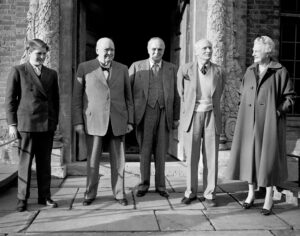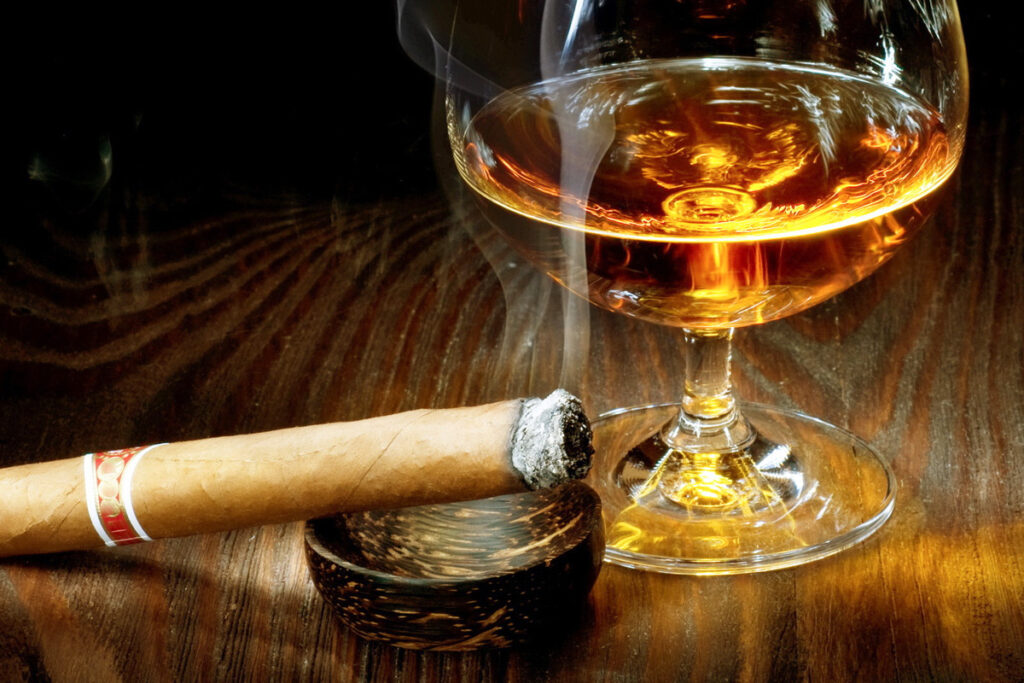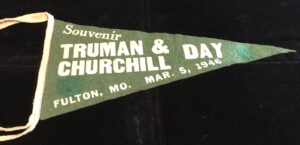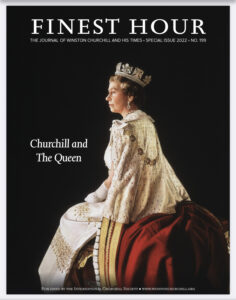
Bulletin #174 — Nov 2022
The Wee Dram

October 29, 2022
Perspectives on Churchill from Scotland
By ALASTAIR STEWART
Editor’s Note: The Wee Dram is a new occasional column that will provide views of Winston Churchill from the perspective of Scotland, a country with which he had a lifelong connection. The 2023 International Churchill Conference will take place in Edinburgh next October 5–7. For more information, please CLICK HERE.
How to begin a new series about Churchill and Scotland? What image, what thought, and what profound degree of perspicuity is appropriate to launch a column about Winston Churchill’s connections to Scotland?
There can, like Highlander—be only one. During a 1911 visit to Balmoral, Scotland, Churchill had his new red automobile, a 15-horsepower, 4-cylinder Napier Landaulette, delivered to the King’s residence.

2024 International Churchill Conference
And what does our future prime minister, the future saviour of the Western world, do? He takes off and drives it to Clementine’s family home at Airlie Castle.
A 30-something Churchill, wind tussling his thinning mop of red hair, speeding through the Scottish highlands is quite the thought. He was a young man, and many of those formative, personal and professional years were spent in Scotland.
And he does not stop there. Churchill drove the next day to meet Prime Minister H. H. Asquith at Archerfield House on the coast of East Lothian. Here Churchill was invited to take over as First Lord of the Admiralty.
To international readers, it is massively important to understand that Churchill is not some dusty historical myth. In Scotland, we live under the yoke of our history, deployed daily to make a case for Scottish independence or staying within the United Kingdom.
To many Scottish nationalists Churchill is a bogeyman. He is the man who ordered tanks to crush striking workers in the 1919 Battle of George Square. He is the man who abandoned the 51st Highland Division at St Valery in 1940. And he was the man prepared to sacrifice Scotland to the Nazis to protect the south of England.
All of it is hogwash. These slanderous accusations are weeds, grown tall by the absence of a concerted effort by Scots to tidy their historical backyard. It is even incorrectly reported that Churchill was in Scotland, not with his daughter Marigold, when she passed in 1921. Churchill, in fact, mourned the little girl in Scotland shortly after her death.
The absence of a single standard resource about Churchill’s Scottish connections has created a culture where anything goes if it is said often enough. He is either an immaculate and faultless leader or a mass murderer (as one Member of the Scottish Parliament tweeted in 2019).
But the real truth is there, right in front of us, buried in every index page of every biography and every volume of The Churchill Documents. The Scottish connections are professional, personal, and familial. They are threads which need to be pulled together. Doing so will contextualise a man who had more links to Scotland than any prime minister since 1945, with the exceptions of Sir Alec Douglas Home (who served as Churchill’s Minister of State for Scotland in the 1950s) and the Giffnock-born Gordon Brown, now himself an honorary member of the International Churchill Society.
After years of writing about Churchill and Scotland, I find no greater nugget of truth to be so funny as the fact that Churchill was good friends with a founder of the Scottish National Party. Serving as Churchill’s adjutant on the Western Front in 1916 was Major Andrew Dewar Gibb MBE KC, then a captain, who became a founder of the SNP in 1934 and led the party from 1936 to 1940. Serving alongside Churchill and Dewar Gibb in the same trenches was Archibald Sinclair, another Scot, who led the Liberals from 1935 to 1945 and who served in Churchill’s wartime government.
Churchill himself was the Liberal MP for Dundee for fourteen years. Conventional wisdom holds that Churchill was chased out of the city. Look a little deeper, and you will see his vote share return in 1918 was nearly four times more than when he was elected in 1908. That he lost to a Prohibitionist candidate in 1922 is one of history’s great punchlines. The same year Churchill was elected to Dundee, he married Clementine Hozier, a granddaughter of the tenth Earl of Airlie.
Churchill was Home Secretary and First Lord of the Admiralty, tackled Irish Home Rule, was heckled by the Suffragette movement, and fought in the First World War—all while serving as MP for Dundee.
A privately funded plaque commemorating Churchill’s campaign headquarters was erected at the Queen’s Hotel in Dundee in 2008. There is also a copy of a letter he sent to his wife Clementine, famously complaining about a maggot in his kipper that “flashed his teeth.” Beyond that, nothing suggests he was there in the city for as long as he was.
Only a smattering of other acknowledgements of Churchill exist across Scotland. In the capital, a bust sits in the City of Edinburgh Council building, and there is a Churchill suite in the capital’s Prestonfield Hotel. In the Edinburgh Central Library, a plaque honouring suffragist Elsie Inglis includes a tribute from Churchill reading, “She will shine forever in history.”
At the Dalmeny Estate, the family seat of the Earldom of Rosebery, there is a tree planted by Churchill in 1946. Over on the Orkney Islands, Willie Budge’s 2011 monument to the Churchill Barriers at Scapa Flow is a silhouette of Churchill made from a rudder.
Beyond a miniature sculpture in Glasgow’s Kelvingrove Museum and an impressive portrait of Churchill by Sir James Guthrie in the Scottish National Portrait Gallery in Edinburgh (see the cover of Finest Hour 189), there is nothing befitting a country famed for cashing in on even the most tangential of tourist connections.
Consider that Churchill’s favourite whiskies were the Johnnie Walker Red and Black Labels. They formed the basis of his daily whisky and water, a drink which his children called a “Papa Cocktail.” Johnnie Walker is a brand of Scotch whisky now owned by Diageo that originated in the Scottish burgh of Kilmarnock in East Ayrshire. His favourite dessert was even, quite aptly, Dundee Cake.
Randolph Churchill contested the Scottish constituency of Ross and Cromarty in 1936. The Edinburgh Evening News, rather wonderfully, if prematurely, claimed the loss “seems to be regarded as another nail in the political coffin” of his father.
Churchill flew north to Scotland in September 1952 to be the Queen’s guest at Balmoral. While there, he was informed that Britain’s first atom bomb was detonated successfully at Montebello Island, off the northwest coast of Australia. Churchill would have informed the Queen of this fact, and it is sobering now to think that the conversation took place in the same location at which Her Majesty would die seventy years later.
This series, and broader efforts by the International Churchill Society and its new Scottish chapter, is committed to illuminating how Scotland shaped Churchill and how he influenced Scots. Only over time can a complete picture be formed and, hopefully, passed into the lexicon of Churchillian knowledge that so many of us appreciate.
So let us not start with a grain of truth. Let us start with a dram, and see where it takes us. Slàinte!
Alastair Stewart is a freelance journalist who regularly contributes to the The Scotsman and other newspapers. He serves as chair of ICS–Scotland.
Subscribe
WANT MORE?
Get the Churchill Bulletin delivered to your inbox once a month.




